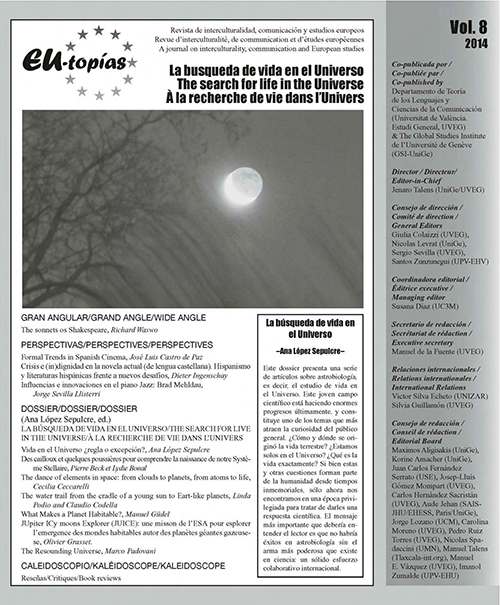What Makes a Planet Habitable?
DOI :
https://doi.org/10.7203/eutopias.0.18778Mots-clés :
Exoplanètes, habitabilité, vie Résumé
Résumé
Afin que la vie puisse apparaître et se développer sur la surface d’une planète, des nombreuses conditions de nature astrophysique sont nécessaires. Le rayonnement et les particules provenant de l’étoile centrale, le champ magnétique planétaire, l’accrétion ou dissipation de l’atmosphère d’une jeune planète, et plusieurs autres facteurs doivent agir ensemble et de façon équilibrée pour que la vie ait l’opportunité de prospérer. On décrit ces prérequis cruciaux pour l’habitabilité et on discute le dernier état de connaissance.
 Téléchargements
Téléchargements
 Références
Références
Feulner , Georg (2012) “The faint young Sun problem”, Reviews of Geophysics, 50, CiteID RG2006.
Elkins-Tanton , Linda T. (2008) “Linked magma ocean solidification and atmospheric growth for Earth and Mars”, Earth Planet. Sci. Lett., 271, pp. 181-191.
Grenfell , John L., et al. (2014) “Sensitivity of biosignatures on Earth-like planets orbiting in the habitable zone of cool M-dwarf stars to varying stellar UV radiation and surface biomass emissions”, Planet. Space Sci., 98, pp. 66-76.
Güdel , Manuel, et al. (2014) “Astrophysical Conditions for Planetary Habitability”. In Protostars and Planets VI, in press.
Kasting, James F. (1988) “Runaway and moist greenhouse atmospheres and the evolution of earth and Venus”, Icarus, 74, pp. 472-494.
Kasting, James F.; Whitmire , Daniel P.; Rey – nolds , Ray T. (1993) ”Habitable Zones around Main Sequence Stars”, Icarus, 101, pp. 108-128.
Kasting, James F.; Catling , D. (2003) “Evolution of a Habitable Planet”, Annu. Rev. Astron. Astrophys., 41, pp. 429-463.
Khodachenko , Maxim L., et al. (2012) “Magnetospheres of “Hot Jupiters”, Astrophys. J., 744, pp. 70-86.
Kislyakova , Kristina G., et al. (2013) “XUV-Exposed, Non-Hydrostatic Hydrogen-Rich Upper Atmospheres of Terrestrial Planets. Part II: Hydrogen Coronae and Ion Escape”, Astrobiol., 13, pp. 1030-1048.
Lammer , Helmut, et al. (2013) “Outgassing History and Escape of the Martian Atmosphere and Water Inventory”, Space Sci. Rev., 174, pp. 113-154.
Lammer , Helmut, et al. (2014) “Origin and loss of nebula- captured hydrogen envelopes from `sub’- to `super- Earths’ in the habitable zone of Sun-like stars”, Mon. Not. Roy. Astron. Soc., 439, pp. 3225-3238.
Lang, Kenneth (1999) Astrophysical Formulae, New York: Springer.
Mayor , Michel; Queloz , Didier (1995) “A Jupitermass companion to a solar-type star”, Nature, 378, pp. 355-359.
Ribas , Ignasi; Guinan, Edward F.; Güdel , Manuel; Audard , Marc (1995) “Evolution of the Solar Activity over Time and Effects on Planetary Atmospheres”, Astrophys. J., 622, pp. 680-694.
Rondanelli , Roberto; Lindzen , Richard S. (2010) “Can thin cirrus clouds in the tropics provide a solution to the faint young Sun paradox?” J. Geophys. Res., 115, D02108.
Sackmann, I.-Juliana; Boothroyd , Arnold I. (2003) “Our Sun. V. A Bright Young Sun Consistent with Helioseismology and Warm Temperatures on Ancient Earth and Mars”, Astrophys. J., 583, pp. 1024- 1039.
Wagner , Frank W. (2011) “Interior structure models of solid exoplanets using material laws in the infinite pressure limit”, Icarus 214, pp. 366-376.
Wood , Brian E. (2004) “Astrospheres and Solar-like Stellar Winds”, Liv. Rev. Solar Phys., 1, no 2.
Téléchargements
Publiée
Comment citer
-
Résumé253
-
PDF 76
Numéro
Rubrique
Licence
![]()
Tous les contenus publiés dans EU-topías. Revista de Interculturalidad, Comunicación y Estudios Europeos est sous licence Creative Commons Paternité-Pas d'Utilisation Commerciale-Partage des Conditions Initiales à l'Identique 4.0. Le texte complet de la licence peut être trouvé à http://creativecommons.org/licenses/by-nc-sa/4.0
Ils peuvent être copiés, utilisés, diffusés, transmis et affichés publiquement, à condition que:
- L'auteur et la source originale de la publication sont cités (magazine, éditeur et URL de l'œuvre).
- Ils ne sont pas utilisés à des fins commerciales.
- L'existence et les spécifications de cette licence d'utilisation sont mentionnées



